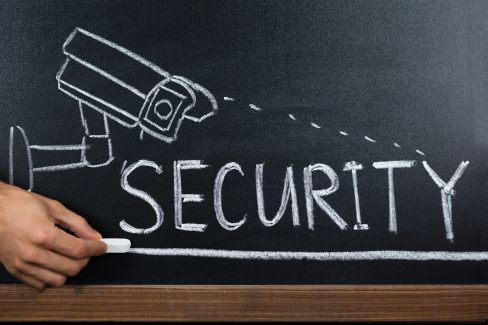October 13, 2020 by Kim Morgan
When Mindsight last dove into EdTech trends in 2018, the world was a very different place. Tiger King was relatively unknown, the Washington Nationals had yet to win a World Series, and, of course, the world had yet to be gripped by COVID-19. In this era of “new normal”, what has changed since then, and what remains the same?
In 2018, we cited these 3 emerging trends in EdTech:
- Security: Physical and Digital
- Edge Computing and Cloud Services
- Data-Driven Instruction
- Adaptive Learning, AI, and the Internet of Things (IoT)
- Gamification and Immersive Learning
Today, we will explore and expand on how these trends are so vital to this new world of hybrid and remote learning and why these technologies are probably here to stay.

Security: Physical and Digital
Security, both physical and digital are still top of mind in schools. IT departments are increasingly involved in the technical implementation of smart-tech that protects students, staff, and the campus. Districts recognize the value in combining physical and cybersecurity planning under one domain, and IT is a strategic voice in developing campus security master plans.
Among recent K-12 EdTech trends: video surveillance and access management. As of 2018, 94% of high schools use security cameras to monitor the inside of schools and their surrounding grounds. The wide availability of IP cameras at all price points have made it easier for schools to implement these devices. And now, with schools being less crowded, the need for surveillance has risen even further.
From metal detectors to buzzer systems and beyond, school districts are also developing strategies to monitor and manage building access. Locked-door systems, protective glass, reinforced vestibules, single-point entry, and perimeter fences are some of the ways schools are seeking to protect students from physical threats. These additions do not come fully unopposed, which is why it is important to seek input from the community at large when developing a security plan.
Security extends beyond the physical realm, though. Schools must comply with FERPA and other privacy regulations that protect student education records. As teachers and administrators seek to utilize third-party vendors to store, monitor, scaffold, and analyze student data, IT is faced with a growing list of platforms to manage.
 Edge Computing and Cloud Services
Edge Computing and Cloud Services
Because of COVID-19, blended learning models are a MUST-HAVE. Through the summer of 2020 educators, administrators, and researchers sought ways to integrate online and in-person learning models, and hope that by doing so they will better meet students where they are and provide scaffolding so they can get to where they need to be.
Part of this transition is moving resources and applications to the cloud. Since many districts use large public clouds, like Amazon Web Services (AWS) or Microsoft Azure, the other aspect of this trend to watch is edge computing. The central idea of edge computing is that data is processed closer to its point of origin, reducing the amount of data that needs to travel all the way to the cloud.
This is a big step for schools, where meeting even basic broadband network goals can be a challenge. Edge computing can help compensate for this, by prioritizing data processes for strategic education initiatives.
In any cloud deployment model, security is paramount. Student data – both personal student information (name, address, social security number, etc.) and student education records are subject to strict security policies. But implementing those policies can be a challenge. Cloud Access Security Brokers (CASBs) like Cisco SecureX are one tool IT departments can utilize an effort to secure the cloud infrastructure, defend against data breaches and attacks, and facilitate security through simple, open APIs. In 2020, these tools often seamlessly integrate into physical security systems, creating a more even experience for teachers and students.
Since Mindsight is a Cisco Gold Partner, we can provide proof of concept, demos and support in utilizing tools like Cisco SecureX. Contact us today to arrange for a demonstration or begin a discussion about how these tools can work for your school district.

Data-Driven Instruction
Data-driven instruction is rising in the U.S. Using data to analyze and scaffold is nothing new, neither is sharing that data amongst staff. But technology is giving way to a new kind of data sharing, which is two-fold:
Data is shared internally:
- Student <-> Student
- Student <-> Teacher
- Teacher <-> Administrator
Data is shared with third parties:
- Researchers
- Vendors
- Government entities
- Nonprofits
Data sharing is rife with challenges. FERPA, or the Family Educational Rights and Privacy Act, is dedicated to protecting the information of children in the education system. Enforcing that policy, however, is not always an easy path.
Although the U.S. government does provide guidance with their data sharing toolkit, IT departments are tasked with implementing policies in their districts that protect student data. As this Education Week report demonstrates, schools, government agencies, educators, administrators, researchers, parents, and students all have skin in the game. It can be a hard line to toe.
Now, more than ever, as students are either full-remote or in a hybrid learning model, these applications help teacher assess the progress of their students from afar. Today, these apps are used K-12 with little to no instruction for the students, an added bonus for teachers and aides who are already multi-tasking tech platforms.
To be successful, IT needs to collaborate with staff to determine how to implement data sharing tools – like Khan Academy, PowerSchool, ALEKS, Illuminate Education, Dreambox, G-Suite, Edgenuity, ST Math, and NWEA Map – to name a few. These are useful tools, but will only work when implemented strategically with student data protection in mind.
Adaptive Learning, AI, And The Internet Of Things (IoT)
Adaptive learning is already here. “Check-in” assessments that respond to a student’s answers by modifying content to meet the student – either above or below – is common in data sharing tools. These resources can scaffold lessons, layering complexity with supports to ensure success. Artificial Intelligence (AI) makes this possible. AI will also be used to perform debates and scaffolded Socratic exercises with students.
Teachers assign modules through platforms like Zearn, IXL and Lexia PowerUp, and students complete them during independent work time. If a student answers incorrectly, the platform will “take them back” to a more basic form of the question in order to “propel them forward” to the next part. This is especially relevant when teachers and aides are not physically present during independent learning because a student is social distanced or remote.
From a refrigerator that texts when you need more milk to the Alexas and Google Homes ordering laundry detergent or calling Grandma, smart technology that is part of the Internet of Things (IoT) is here to stay.
In education, smart technology has been around for over a decade. SMART boards enable teachers to provide interactive activities, pull up documents and worksheets, and share videos and more with their students.
Where is IoT in education today?
Last year, IBM announced it would be investing $3 billion in IoT with a focus on education. Automating administrative duties and enabling educators to focus on the actual teaching is the main objective, as is data management and processing.
IT departments will be at the forefront in training, managing, and leading the implementation of these tools.
 Gamification And Immersive Learning
Gamification And Immersive Learning
As in 2018, gamification is more and more prevalent in the tools with which students interact. Kids (and adults) enjoy video games – from the early NES versions of Mario Bros to the recent mega-hit Fortnite, and back to the Mario properties with the launch of the Nintendo Switch, gaming is becoming a more accepted part of recreational culture. Video game sales have set new records in the era of COVID-19, 36.54% for consoles alone.
Educators attempt to harness this enthusiasm by injecting an element of “gamification” in learning apps, especially when the content seems daunting or repetitive. “I like the noise it makes when I get it right the first time”, says first grader Nelly, “doing work on paper doesn’t sound as nice”. Gamification also underscores the point teachers have been trying to make for centuries, that learning is, in fact, fun.
The K-12 classroom is a busy place. IT teams in these schools are tasked with the difficult job of managing a wealth of disparate technologies while coordinating with teachers, parents, administrators, students, and the larger community. Paying attention to K-12 EdTech trends can help a district move towards the future by preparing their students for tomorrow today.
Contact us today to discuss how to implement these and other K-12 EdTech trends in your school district.
About Mindsight
Mindsight, a Chicago IT services provider, is an extension of your team. Our culture is built on transparency and trust, and our team is made up of extraordinary people – the kinds of people you would hire. We have one of the largest expert-level engineering teams delivering the full spectrum of IT services and solutions, from cloud to infrastructure, collaboration to contact center. Our highly-certified engineers and process-oriented excellence have certainly been key to our success. But what really sets us apart is our straightforward and honest approach to every conversation, whether it is for an emerging business or global enterprise. Our customers rely on our thought leadership, responsiveness, and dedication to solving their toughest technology challenges.
Contact us at GoMindsight.com.

